Suspicious minds
Mingling with wariness and wonder at a conference devoted to “Ancient Aliens.”
PASADENA, Calif. — It was barely two hours into Day 1 of AlienCon and 500 years of accepted history and science were already being tossed out. Three thousand people had gathered inside the Civic Auditorium here for a panel discussion featuring presenters from “Ancient Aliens,” a History Channel documentary series.
Everyone had questions: about whether we were alone in the universe; about what our government really knows; about humanity’s very origins.
One of the network’s most popular and longest-running shows (Season 13 resumed on July 20), “Ancient Aliens” is itself a series of questions. Many are posed rhetorically by an unseen narrator intoning over a wide shot of a rubbly archaeological site. According to the show’s talking heads, extraterrestrials may have had a role not only in the extermination of the dinosaurs, but also in the construction of the Egyptian pyramids.
Carl Sagan, the popular scientist who captivated television audiences of the 1970s and ’80s, once said: “Extraordinary claims require extraordinary evidence.”
But Mr. Sagan has been dead for years, and many Americans of the internet age have been in a mood to challenge established ideas. There has been a resurgence of the flat-earth theory. More than a few believe that global warming is a hoax, that survivors of mass shootings are crisis actors.
Yet for many at the conference, and elsewhere, this is not simply a political divide. We now know that the history that had been taught for years excluded the experiences of so many (African-Americans, women, the working poor). What else had been left out? Trust in the government and leaders who could set it all straight is historically low.
And there are so many people ready to believe that aliens visited Earth before recorded history that some 10,000 attendees paid to visit this conference over three days.

From left, Wes Davis, Andrew Tran and Mike Brumfield. Mr. Brumfield traveled from Piketon, Ohio, to share his theories about aliens' influence on Western beauty culture. CreditAdam Amengual for The New York Times

A full house in the Civic Auditorium for an event called “50 Years of Chariots of the Gods."CreditAdam Amengual for The New York Times
In the audience was Chris Bayley, a neatly dressed lawyer who had traveled from Arizona with his two adult sons. “Just because someone says the Egyptians made the temples with ropes and wooden rollers doesn’t make it true,” Mr. Bayley said. “We shouldn’t accept blindly things we’ve been taught by quote-unquote scientists.”
Earlier that morning, a woman had risen from the crowd and told the “Ancient Aliens” producers: “I’m indoctrinating my children in your show so they’ll ask questions and not believe everything they’re told.”
During the question-and-answer period, a wheelchair-bound man of about 60 was handed a microphone. He asked, “Do you believe we are indigenous to this planet?”
It was Giorgio who answered him, naturally: Giorgio A. Tsoukalos, 44, the show’s breakout star, the one they’d most come to see and get their picture with. He was dressed as he would be all weekend, in the khaki shirt and pants and sturdy leather boots of a field archaeologist, though in the strict academic sense, he has no such accreditation.
Before appearing on TV, he worked as a bodybuilding promoter while publishing “Legendary Times,” a newsletter about extraterrestrials. He is one of the show’s so-called Ancient Astronaut Theorists.
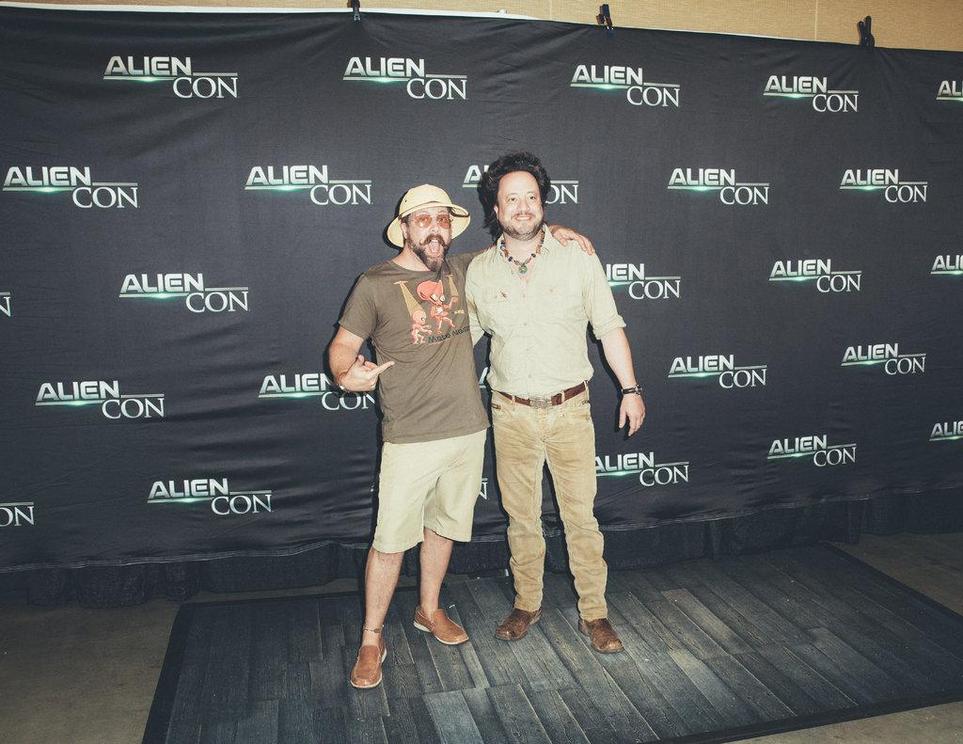
Douglas Smythe, left, and Giorgio A. Tsoukalos, the host of "Ancient Aliens." Fans like Mr. Smythe paid an extra fee to be able to meet and take a picture with Mr. Tsoukalos.CreditAdam Amengual for The New York Times
It is not fancy credentials but the way he expresses gut beliefs that makes him compelling to viewers; that, and his hair. Perhaps no other figure in current American life besides the president is so vividly linked to a hairstyle. The do was as epic in person: a brown bushy bird’s nest sprayed up on all sides to achieve absurd height. It gave him a look of perpetual amazement, or of someone who had been electrocuted.
The man in the wheelchair waited along with the crowd to hear if Earth was in fact our ancestral home. Behind the speakers’ table, Mr. Tsoukalos leaned in and, as he so often does on TV, made an incredible claim with total confidence and a goofy grin.
“No.”
“Exactly,” the man said, and practically dropped the mic.
The Family of Alien Theory
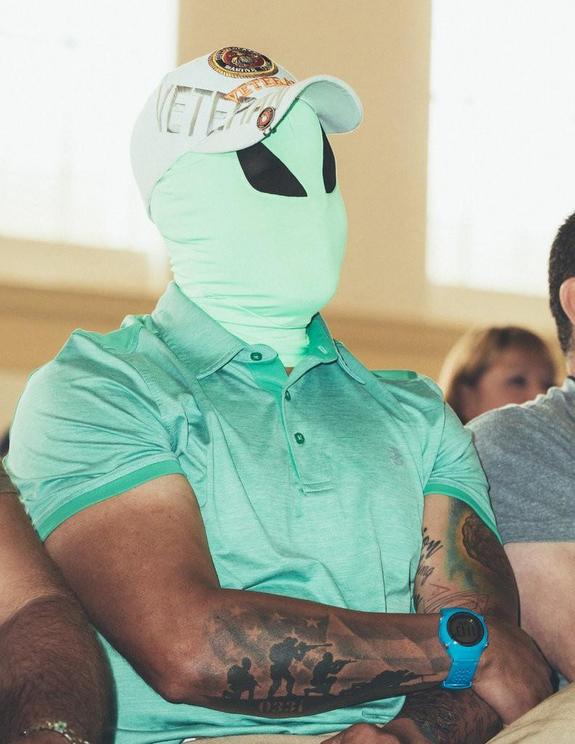
Make aliens great again: One conference attendee clapped a baseball cap atop his face mask.CreditAdam Amengual for The New York Times
The primary pathway into “Ancient Aliens” and the ancient astronaut theory is a book called “Chariots of the Gods?” Rivaling “Led Zeppelin IV” as a mystical hippie-era artifact passed through the generations, it suggests that extraterrestrials gave technology and culture to the Egyptians, Mayans and other ancient civilizations — which sounds fringy, except it has sold more than seven million copies, with a 50th anniversary edition out from Berkley Books this summer. The 1970 documentary film of “Chariots” was nominated for an Academy Award.
The book’s Swiss author, Erich von Däniken, flew 12 hours from Zurich with his ponytailed young assistant, Ramon, to speak at AlienCon. Eighty-three and slightly stooped, he still works every day, he told me backstage on Day 1, crisscrossing the globe “like a missionary.”
With his severe Swiss-German accented English and tetchy impatience with critics, Mr. von Däniken is now, with the visibly amped Mr. Tsoukalos, one of the familiar personalities of “Ancient Aliens.”
There is also George Noory, the genial mustachioed host of the late-night radio show “Coast to Coast AM;” Linda Moulton Howe, who once made a documentary suggesting that flesh wounds on some Alabama cattle were alien markings; Nick Pope, an ex-British Ministry of Defense official; and William Henry, a groovy “investigative mythologist.”
David Hatcher Childress, who gets nearly as much screen time as Mr. Tsoukalos, is a real-life Indiana Jones who climbs megalithic ruins in Lebanon’s Bekaa Valley equipped with a brown felt hat and a notebook. Since 1984, he has operated Adventures Unlimited Press, whose hundreds of paperback titles, several of which he has written, roughly chart the conspiracy du jour: Atlantis, Nikola Tesla, the Mayan calendar, recently Bigfoot.
Before “Ancient Aliens,” these believers had been scattered on the margins, hawking their ideas at small gatherings in the Nevada desert. Now they’d been unified under one tent and given a podium by a network with the sheen of educational TV. Did that awesome responsibility temper them?
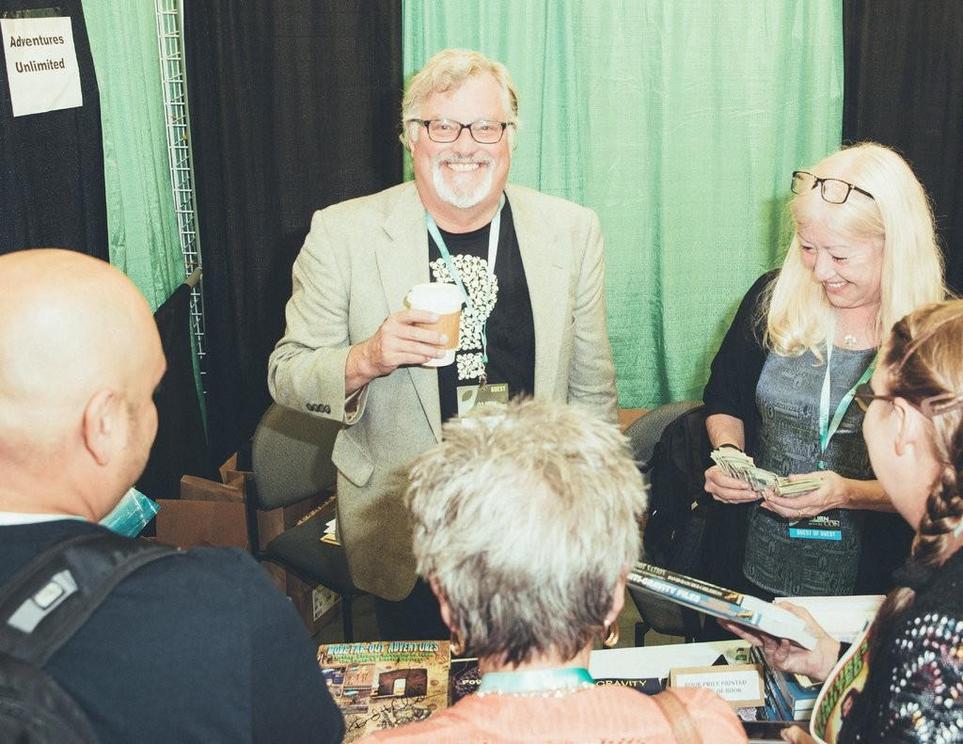
The author and "Ancient Aliens" host David Hatcher Childress and his wife, Jennifer Bolm, selling books and signing autographs at their booth in the vendor area.CreditAdam Amengual for The New York Times
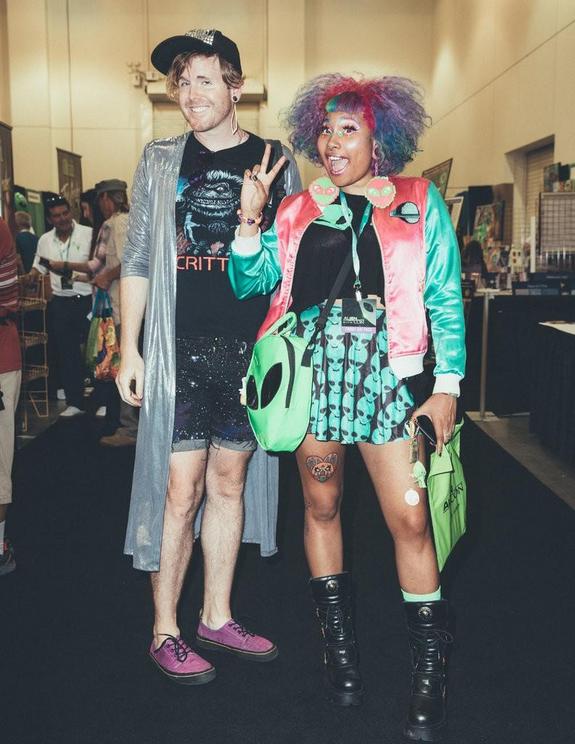
Tom Blunt and Mabel Garcia, who attended the conference.CreditAdam Amengual for The New York Times
Here’s Mr. Childress, in an episode from Season 10 called “The Alien Architects”: “So here we have an ancient grid structure, probably built by extraterrestrials, possibly to power their craft, that’s now being reconstructed today by the military.”
Such broad, unverified claims are why “Ancient Aliens” is taken by some to be carnival entertainment (see the Viceland stoner spinoff “Traveling the Stars: Action Bronson and Friends Watch ‘Ancient Aliens’”) — and by others as something darker, a show that traffics in intellectual hucksterism and challenges facts.
“The Idiocy, Fabrications and Lies of ‘Ancient Aliens,’” reads one headline from Smithsonian.com. Another critique, posted to Medium by Barry Vacker, a professor at Temple University, argued that since the Apollo 11 mission, Americans have lacked a popular narrative to explain the vast cosmos and our origins and destiny within it.
“In ‘Ancient Aliens,’ we can see philosophy’s mediated corpse,” writes Mr. Vacker, who called the show “an attack on logic, rationality, and the nature of evidence.”
For Kevin Burns, naysayers like Mr. Vacker add little to the discussion. A veteran TV producer who is often confused with the highbrow filmmaker Ken Burns (“I do the ones in color,” he likes to say), he was old enough to remember “Chariots of the Gods?” and to notice similarities with the 2008 movie “Indiana Jones and the Kingdom of the Crystal Skull,” which Lucasfilm hired him to promote with a TV special.
Envisioning an updated “Chariots,” he approached the History Channel with the “Ancient Aliens” concept, which grew from a two-hour special into a series.
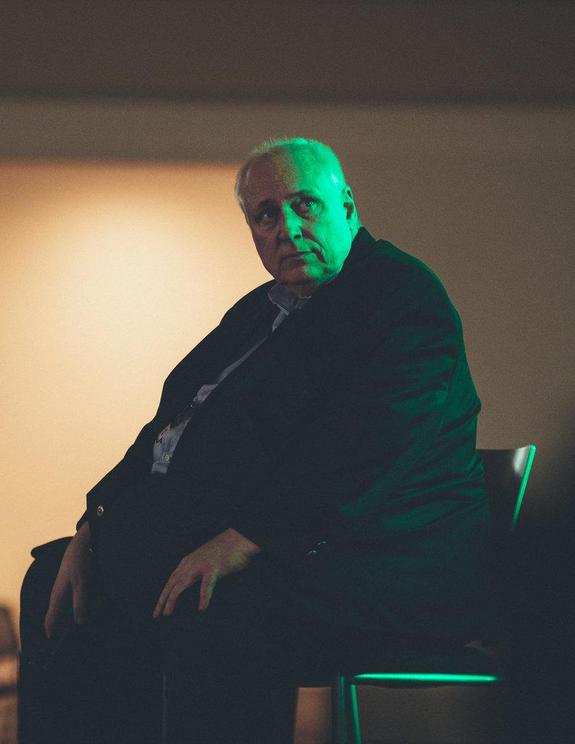
Kevin Burns, the executive produer of "Ancient Aliens," watches a sneak peak of an unreleased episode.CreditAdam Amengual for The New York Times
Initially, Mr. Burns included skeptics on the show. But, he said, “we found that they had nothing to say, other than, ‘There’s no proof, there’s no proof.’ If we were going to do a show about the birth of Jesus, would we have people who say, ‘This is ridiculous?’ No.”
The invocation of religion is deliberate. In Mr. Burns’s view, “Ancient Aliens” succeeds because it explores spirituality and the mystery of life in an increasingly secular, data-driven culture. Like religion, it offers seekers an origin story.
“It’s not about little green men in outer space. That’s the three-headed snake lady that gets you into the tent,” Mr. Burns said. “It’s really a show about looking for God. Science would have you believe we are the result of nothing more than a chance assemblage of matter. The real truth is we don’t know.”
The questions posed by the ancient astronaut theorists, however far-fetched, serve a rare purpose, according to Mr. Burns: “It allows the audience to wonder. And very few things on television do that.”
Selling the Stardust
In the “Marketplace” — the gymnasium-size room at AlienCon with the merch booths — the cast members existed comfortably with crystal jewelry sellers; practitioners of iridology and divine muscle testing; the author of a science-fiction series called “Gray Guardians”; the producers of the U.F.O. government cover-up thriller “The Phoenix Incident”; Sasquatch Syndicate, which sold Bigfoot action figures; a man and woman into cosplay who were both dressed like Giorgio; and the promoters of the Sedona Orgone Vortex, which promised to produce positive energy and block electromagnetic fields.
On Day 1, a disheveled-looking Jack Nicholson was spotted checking out the offerings. Or was it an impostor? Another mystery.
In the long line of fans who had paid $25 to get Giorgio’s autograph was Fabian Garcia, who had come with his daughter, Amanda, and young grandsons, Ashton and Cruz. Mr. Garcia said he wanted to get the full story from the “Ancient Aliens” producers and cast. “I want to go, ‘What else can’t you show?’”
That a TV show that devoted an entire episode to how alien technology might have helped Hitler was in any way being censored was surprising to hear. But Mr. Garcia insisted, “I want to know more.”
His grandsons just wanted to meet Giorgio, a cartoon explorer come to life. When Mr. Garcia babysits the boys, he watches “Ancient Aliens.” Now, he said, when he turns on the TV, Cruz, 6, tells him, “Go to the show with the guy with the crazy hair.”
Mr. Burns went on stage and told the fans how he’d met Giorgio, then living near San Diego, and put him on TV. Believing the author of “Chariots” was dead, Mr. Burns had asked a staffer to find the modern-day version.
This was for the “Indiana Jones” TV special in 2008. “I see this strange, tanned, young gentleman with poufy hair,” Mr. Burns recalled. “I said, ‘Who’s that?’ They said, ‘You wanted me to find the new von Däniken. That’s the guy.’ I said, ‘Bring him in.’”
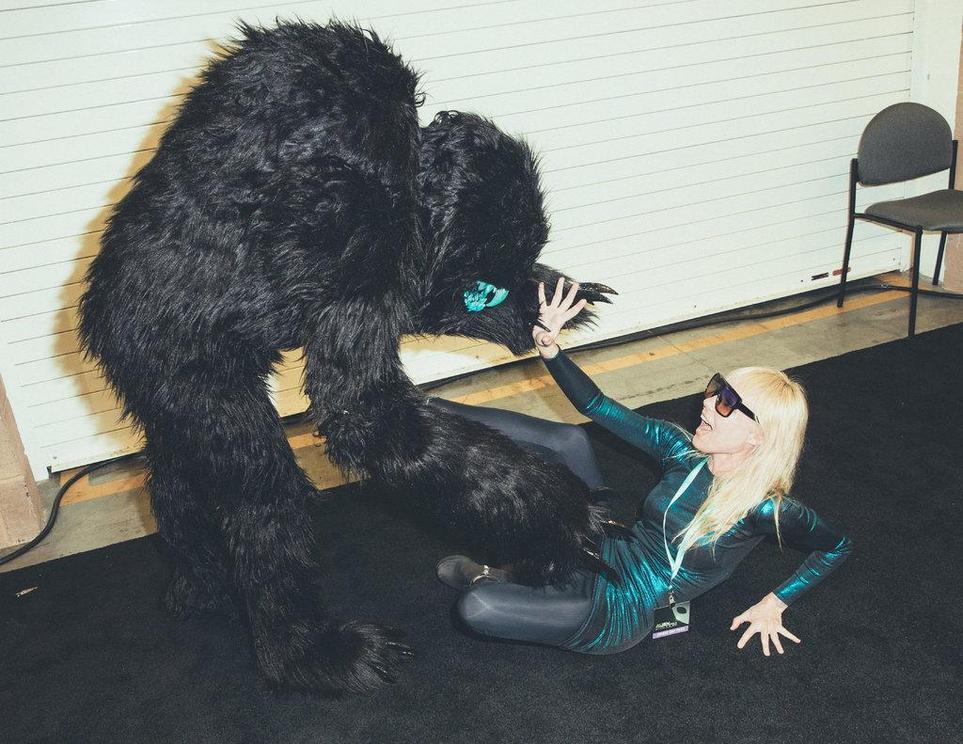
Rayne Mason (in costume) and Sisely Treasure pose for a photo op. CreditAdam Amengual for The New York Times
Over dinner at a Greek cafe in Old Pasadena on the eve of the convention, Mr. Tsoukalos insisted he never intended to become a media personality.
“I never sought out to be on TV,” he said. He was wearing what for him passed as a celebrity disguise: a hat. “It’s a totally weird experience.”
As if to illustrate the point, a woman approached us on the patio and said, “Excuse me. I love the show,” then tried to palm him a $100 bill to buy his dinner. He politely declined.
The next day, I watched him pose for photos for more than an hour with fans, including a feeble old woman who waited until the very end to speak to him. What she whispered to him wasn’t audible to me (and no one would tell me after), but the old woman began weeping. He bent down and comforted her.
What did they see in him?
“That’s one of the greatest mysteries I have yet to solve,” he said lightly.
Mr. Burns told me that his star presenter was initially thrown by his sudden fame, and hurt and embarrassed by a widely circulated meme that sends up his enthusiasm for attributing seemingly any unexplained mystery, and some explained ones, to aliens (“I’m not saying it was aliens … but it was aliens”; “I don’t know. Therefore aliens.”).
He felt, accurately, he was being mocked. A frequent criticism had it that he wasn’t qualified to appear on “Ancient Aliens.” Unfair, really, since M.I.T. isn’t giving out Ph.D.s in ancient astronaut theory.
Mr. Tsoukalos discovered Mr. von Däniken’s books as a boy growing up in Switzerland, at 14 — the ideal indoctrination age, judging by the many convention-goers who said they’d also latched onto “Chariots” in junior high school. Later, he courted Mr. von Däniken as a mentor, and earned a degree in communications from Ithaca College. What was he if not a communicator?
These days, he takes the jokes in stride (“It goes to show the appreciation for the show”) and views his celebrity as “a complete adventure.” A few years ago, he spoofed himself in a Taco Bell ad that aired during the Super Bowl. He will soon appear in a McDonald’s commercial.
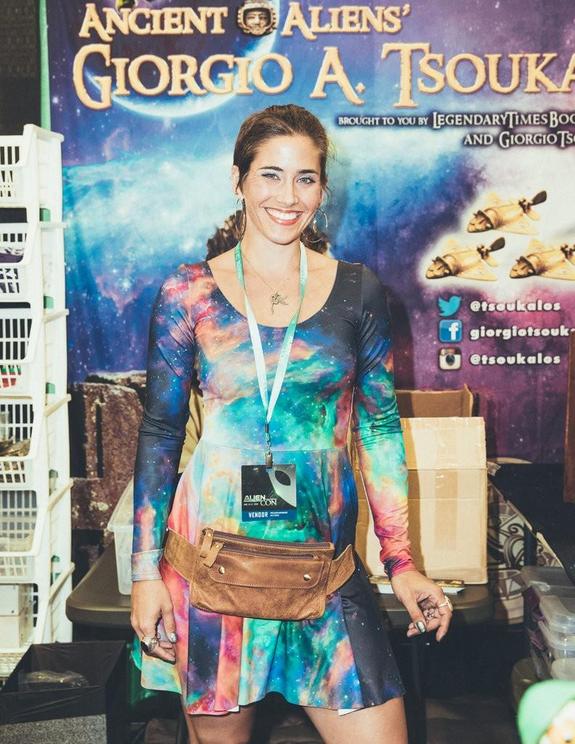
Krix Beeble, Mr. Tsoukalos’s wife, runs the vendor booth, selling signed books, pictures and ornaments as well as her own jewelry.CreditAdam Amengual for The New York Times

Also available for purchase was a bobblehead of Mr. Tsoukalos.CreditAdam Amengual for The New York Times
One sensed he was making decent bank in this field. He has become a co-executive producer of “Ancient Aliens” and travels far and wide filming the show.
While he was doing the AlienCon panels, his wife, Krix Beeble, was doing a brisk business selling T-shirts bearing his face ($25), autographed photos ($25), the little gold spaceship pins that believers wear on their lapel as a Catholic might don a rosary. She designs the glass-bead necklaces ($275) her husband wears on TV, a nifty bit of cross-promotion.
But does he really believe this stuff?
“I don’t believe,” he said. “I know.”
You couldn’t fake the fire in his eyes. Even before our moussaka arrived, he was lecturing me on prehistoric man’s contact with aliens: “They came down from the sky and said, ‘Oh, you don’t know how to make fire? Let us show you.’”
But, he wanted New York Times readers to know, “I’m a skeptic. I don’t buy everything hook, line and sinker. There’s a lot of weird stuff out there, man.”
He mentioned the flat-earth believers. “And then for people to argue, ‘Well, you believe in ancient astronauts so the flat earth isn’t too far-off.’ That’s what I have to deal with. It’s, like, the two are not even related! They’re not even in the same category!”
He sipped his wine and with all seriousness said, “I’m a forensics guy. I need to touch, measure, feel and see things.”
Returning to Earth
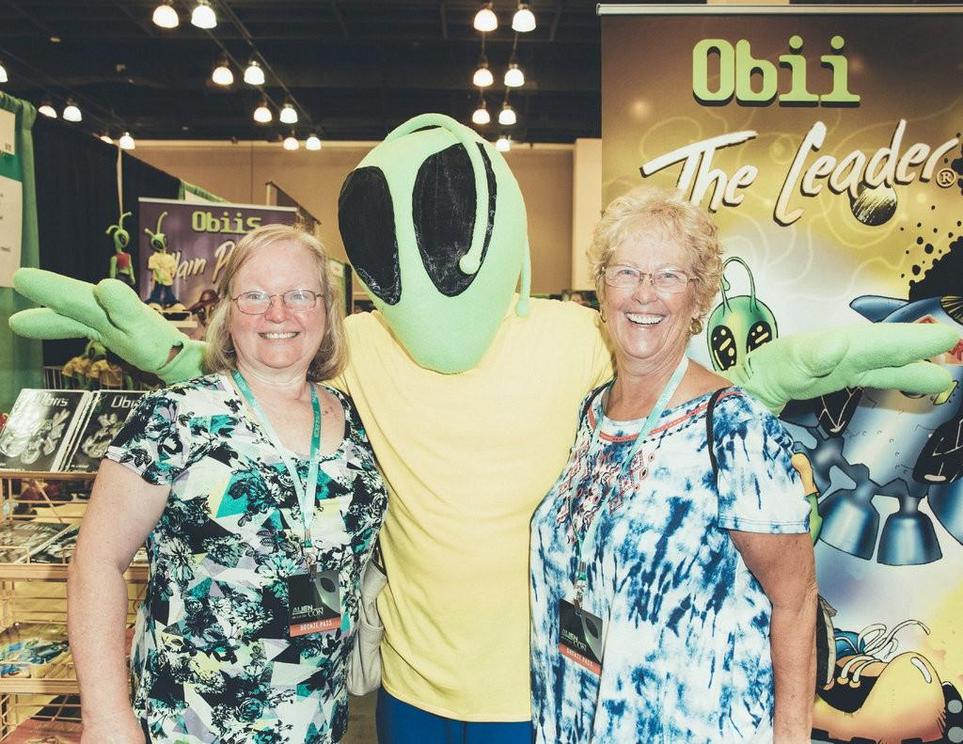
Jeanne Walsh and Shirley Moore pose with the comic-book character Obii.CreditAdam Amengual for The New York Times
A few weeks before AlienCon, I drove to rural Connecticut to see Kenneth Feder, who has a Ph.D. in anthropology. We sat along the Farmington River, across the road from his modest house. In addition to teaching archaeology at Central Connecticut State University, he has a reputation as a debunker of what he called “pseudo-archaeology,” appearing on TV and has written a book, “Frauds, Myths and Mysteries,” which devotes a chapter to ancient astronaut theory.
When I’d arrived, Mr. Feder, 65, had shown me his worn paperback of “Chariots of the Gods?” which he had read as a child of the ’60s along with occultish books on witchcraft and reincarnation. But in college, he said, he took classes with Pedro Armillas, a pre-Columbian Mesoamerican scholar, and moved away from mythology into the science camp.
“A lot of the ancient alien stuff relies on willful ignorance and temporal chauvinism” — a disbelief that ancient people were capable of complex feats of engineering, Mr. Feder said. “I’d read that the building of the Mayan temples was a mystery and think, ‘Why don’t you ask Professor Armillas? He knows exactly how it was done.”
Many of his colleagues in the academy thought it “better not to engage,” Mr. Feder said. “My feeling was it’s a big mistake to ignore this stuff.” The way Mr. von Däniken gathered evidence — “I look worldwide for facts and indications that prove my theory,” he told a Swiss newspaper — was the opposite of the scientific method.
Mr. Feder wasn’t rooting against the ancient astronaut theorists finding hard proof. “If there was a crashed U.F.O. under the pyramids, I’d go, ‘Damn, that’s awesome.’”
But, he added, “Science is all about evidence. The bar has to be higher than Giorgio walking around going, ‘How did they do that? The rocks are so heavy.’”
The ancient astronaut theory was immune to facts, though. It couldn’t be stamped out with reasoning. You laid out the fallacies and people didn’t care.
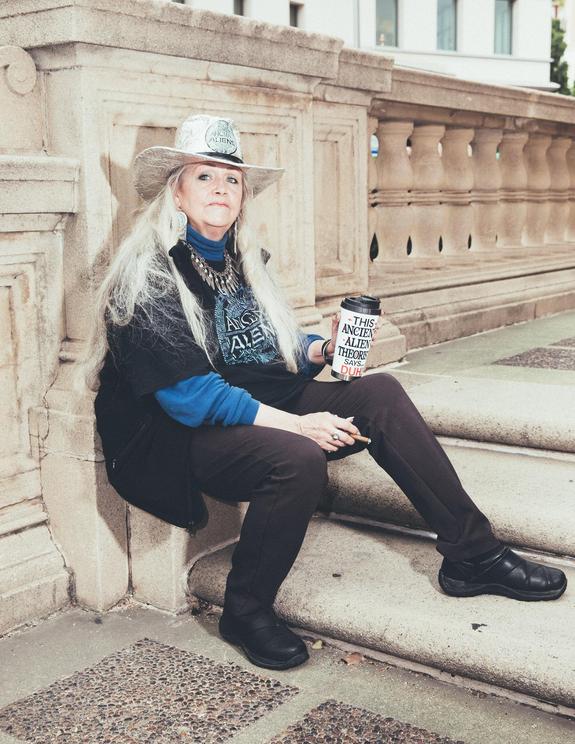
Vicki Jefferies from Livingston, Mont.CreditAdam Amengual for The New York Times
As far back as 1977, a joint BBC and PBS documentary discredited Mr. von Däniken’s thesis, with help from Mr. Sagan, showing how it “rests on inaccuracies, on unrelated facts and false similarities.”
Confronted by the filmmakers, Mr. von Däniken admitted that a piece of evidence in “Chariots” — a photo purported to be a spaceship parking bay on the Nazca Plain in Peru — was “ridiculous.” As a writer, he said, sometimes he was “simply stimulating the reader, and one is allowed to do this.”
Forty years on, the photo was still there in new printings of “Chariots,” uncorrected. At the same time, Ramon, the assistant, told me that there was more demand than ever for his boss to speak, that he was no longer ridiculed. “It’s getting better for him,” Ramon said.
“Ancient Aliens” had its own vigorous rebuttals, including the documentary “Ancient Aliens Debunked,” a three-hour tour de force of critical reasoning undermined somewhat when people discovered the filmmaker was a Christian who believed in the truth of the story of Noah’s Ark.
But in presenting an alternate view of history (“Our past is way different than what we’re being taught in school,” Mr. Tsoukalos told viewers in Season 1, Episode 1), “Ancient Aliens” had come to mean something for a population who felt duped by the so-called experts.
Chris Bayley, the lawyer from Arizona, told me that although he’d been a good sheep in childhood, the truth was, even back then he had doubted the version of the world he was taught. “The show helped validate for me that suspicion,” he said.
And so “Ancient Aliens” was filming new episodes; and Giorgio was starring in fast-food commercials; and amazingly, Mr. Burns said, reruns of old episodes did just as well in the ratings. During AlienCon, he and the organizers announced the conference would expand to the East Coast, to Baltimore this fall.
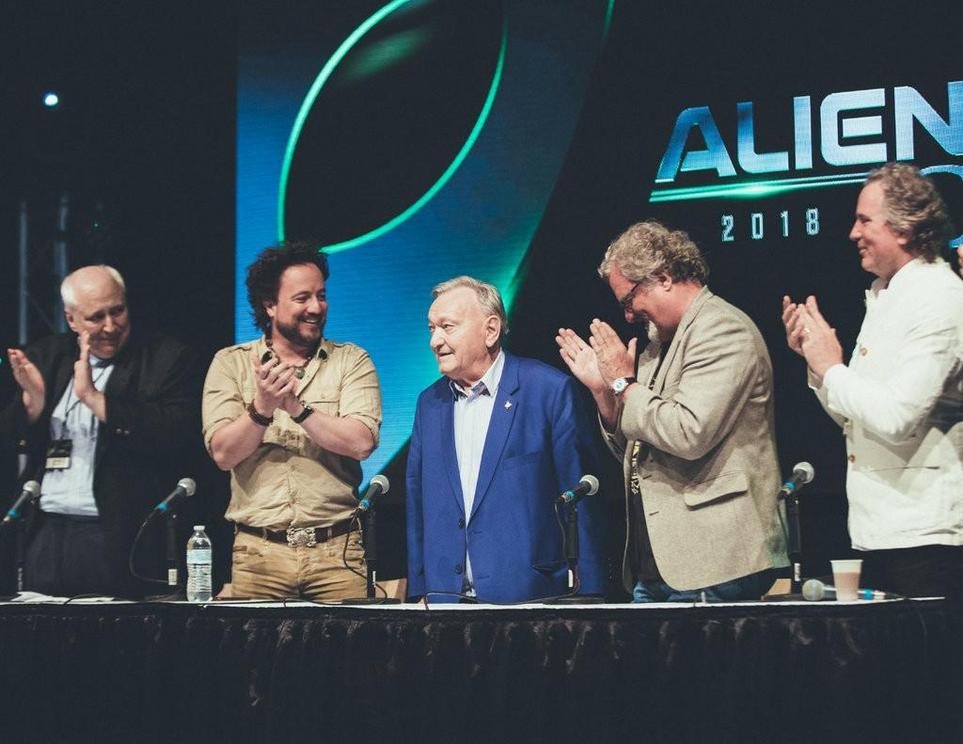
From left, Mr. Burns, Mr. Tsoukalos, Erich von Däniken, Mr. Childress and William Henry during a special event for gold-pass attendees.CreditAdam Amengual for The New York Times
The show had long ago run out of pyramids. It was getting further out in what it covered, mirroring modern life itself. Astronomers were discovering weekly new planets in the habitable zone, emboldening the ancient astronaut theorists.
Last year, The New York Times ran a front-page story on a secret Pentagon U.F.O. program, which inspired a two-hour episode. The presenters were let loose to debate transhumanism, wormholes, God’s presence in sound waves, our brains connecting to a universal intelligence the way a smartphone links to Wi-Fi, our moon maybe a giant spacecraft for extraterrestrials to monitor us.
All these creatively connected dots, these ever-expanding cottage theories discussed by the cast members, it was affecting them. “I’ve always been open-minded, clearly,” Mr. Tsoukalos said. But lately, he had become even more so; he had been considering “the nonphysical realm” — aliens as “something completely ethereal, beings of light.”
Audiences were being radically opened, too. Something had come unanchored. It was inevitable where things were headed. The moment came at one of the “Ancient Aliens” cast panels, during questions from the audience. Everyone listened uncomfortably to a man who spoke at length, in an agitated voice, about certain flaws he’d discovered in the hard sciences.
“Sir, sir, sir. Do you have a question?” Mr. Burns interrupted.
The man exclaimed, “Why don’t you challenge physics and math?”
I left the crowds and walked into Pasadena to get lunch. On the way back, I came upon a low-slung, ’70s-style office building made of tan-brown stucco, with a sign that read, intriguingly, “The Planetary Society,” in a swooshy font.
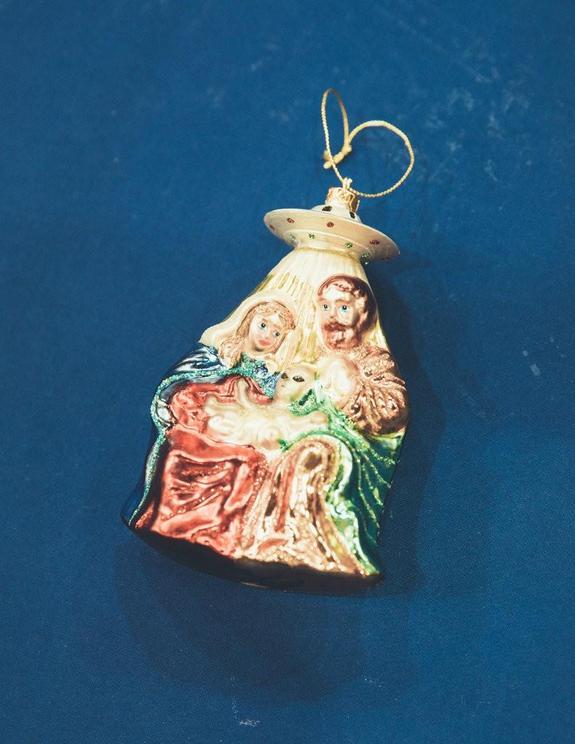
A Christmas tree ornament of Mary and Joseph holding an alien baby Jesus.CreditAdam Amengual for The New York Times
I knocked on the glass door and a young volunteer, Sean, let me in. The nongovernmental, nonprofit organization was dedicated to exploring space and our place within the cosmos, Sean said. One of the founders was Mr. Sagan, who himself had a lifelong fascination with the question of extraterrestrial life. He lent a beautiful quote to the plaque outside, saying of humans on Earth, “We float like a mote of dust in the morning sky.”
The Planetary Society was one block from AlienCon. But it was empty of visitors. Sean gave me a tour of the current exhibit, on solar sailing. A reflective sail is hoisted and the pressure from sunlight is harnessed to propel a small craft around the solar system, as wind moves a sailboat. One of the silvery Mylar LightSails hung from the ceiling.
It was a wondrous, ingenuous idea. It made me think of something Mr. Feder said during our conversation. I’d remarked that “Ancient Aliens” presented exciting ideas about our past. That’s why the show was popular.
To which he had replied: “Isn’t it so much more exciting to believe that humans, through their ingenuity and creativity, built these great structures?”
